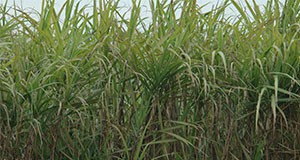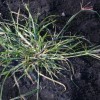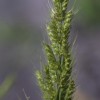 The production systems for sugarcane include either green cane or burnt cane harvesting operations. Sugarcane in Florida is typically harvested with burnt cane mechanical harvesting, but there is a growing interest to better understand the effects of green cane harvest residue “trash blankets” on microclimate conditions for sugarcane growing on both organic and mineral soils of Florida, so the authors conducted a three-year study to determine the effects of each harvest method on microclimate within the surface soil profile and at a 10 cm height from the soil surface. Results are presented in this 4-page fact sheet written by Hardev Sandhu, Maninder Singh, Robert Gilbert, Kelly Morgan, Ronald Rice, Leslie Baucum, James Shine Jr., and Mike Irey, and published by the UF Department of Agronomy, April 2015. (UF/IFAS Photo: Josh Wickham.)
The production systems for sugarcane include either green cane or burnt cane harvesting operations. Sugarcane in Florida is typically harvested with burnt cane mechanical harvesting, but there is a growing interest to better understand the effects of green cane harvest residue “trash blankets” on microclimate conditions for sugarcane growing on both organic and mineral soils of Florida, so the authors conducted a three-year study to determine the effects of each harvest method on microclimate within the surface soil profile and at a 10 cm height from the soil surface. Results are presented in this 4-page fact sheet written by Hardev Sandhu, Maninder Singh, Robert Gilbert, Kelly Morgan, Ronald Rice, Leslie Baucum, James Shine Jr., and Mike Irey, and published by the UF Department of Agronomy, April 2015. (UF/IFAS Photo: Josh Wickham.)
http://edis.ifas.ufl.edu/sc100
Tag: Ronald Rice
Biology and Control of Sorghum-almum in Sugarcane (SSAGR369/SC098)
 Sorghum-almum is a weak, perennial rhizomatous grass. Leaves of seedlings are rolled in a bud with a fringed membranous ligule. Seedlings often resemble corn seedlings when small. Stems of mature plants are stout and erect, reaching up to 14 feet tall. Leaf blades are flat and sandpapery. Sorghum-almum is commonly found in the southern part of Florida in sugarcane fields and along ditches, canals, and roadsides. This 3-page fact sheet was written by Dennis Calvin Odero, Ron Rice, and Les Baucum , and published by the UF Department of Agronomy, January 2013.
Sorghum-almum is a weak, perennial rhizomatous grass. Leaves of seedlings are rolled in a bud with a fringed membranous ligule. Seedlings often resemble corn seedlings when small. Stems of mature plants are stout and erect, reaching up to 14 feet tall. Leaf blades are flat and sandpapery. Sorghum-almum is commonly found in the southern part of Florida in sugarcane fields and along ditches, canals, and roadsides. This 3-page fact sheet was written by Dennis Calvin Odero, Ron Rice, and Les Baucum , and published by the UF Department of Agronomy, January 2013.
http://edis.ifas.ufl.edu/sc098
Biology and Control of Horse Purslane and Common Purslane in Sugarcane (SSAGR368/SC097)
 Horse purslane and common purslane are broadleaf weeds associated with sugarcane fields in muck (organic) and mineral soils of South Florida. Growers often confuse these two weed species with each other. However, these two species have distinct phylogenetic (evolutionary) and morphological differences. This 4-page fact sheet was written by Dennis Calvin Odero, Ron Rice, and Les Baucum, and published by the UF Department of Agronomy, January 2013.
Horse purslane and common purslane are broadleaf weeds associated with sugarcane fields in muck (organic) and mineral soils of South Florida. Growers often confuse these two weed species with each other. However, these two species have distinct phylogenetic (evolutionary) and morphological differences. This 4-page fact sheet was written by Dennis Calvin Odero, Ron Rice, and Les Baucum, and published by the UF Department of Agronomy, January 2013.
http://edis.ifas.ufl.edu/sc097
Biology and Control of Goosegrass in Sugarcane (SSAGR367/SC096)
 Goosegrass is an annual plant that produces a prostrate, mat-like rosette with flattened stems radiating from a central point. It is often described as looking like someone has stepped in the middle of the plant, flattening it out. Because of the whitish to translucent color of the leaf sheath margins, goosegrass usually appears white to silver; this is why it is known as white or silver crabgrass. Goosegrass is found year-round in southern Florida and is commonly associated with newly planted and stubble (ratoon) sugarcane fields. This 3-page fact sheet was written by Dennis Calvin Odero, Ron Rice, and Les Baucum, and published by the UF Department of Agronomy, January 2013.
Goosegrass is an annual plant that produces a prostrate, mat-like rosette with flattened stems radiating from a central point. It is often described as looking like someone has stepped in the middle of the plant, flattening it out. Because of the whitish to translucent color of the leaf sheath margins, goosegrass usually appears white to silver; this is why it is known as white or silver crabgrass. Goosegrass is found year-round in southern Florida and is commonly associated with newly planted and stubble (ratoon) sugarcane fields. This 3-page fact sheet was written by Dennis Calvin Odero, Ron Rice, and Les Baucum, and published by the UF Department of Agronomy, January 2013.
http://edis.ifas.ufl.edu/sc096
Biology and Control of Coast Cockspur in Sugarcane (SSAGR366/SC095)
 Coast cockspur is a relative of barnyardgrass that is native to North America. In South Florida, coast cockspur typically begins to infest sugarcane during the onset of rainfall in late spring. This 2-page fact sheet was written by Dennis Calvin Odero, Ron Rice, and Les Baucum, and published by the UF Department of Agronomy, January 2013.
Coast cockspur is a relative of barnyardgrass that is native to North America. In South Florida, coast cockspur typically begins to infest sugarcane during the onset of rainfall in late spring. This 2-page fact sheet was written by Dennis Calvin Odero, Ron Rice, and Les Baucum, and published by the UF Department of Agronomy, January 2013.
http://edis.ifas.ufl.edu/sc095
Phosphorus Fertilizer Recommendations for Sugarcane Production on Florida Organic Soils (SSAGR348/SC091)
 Much of the sugarcane grown in South Florida is on organic soils in the Everglades Agricultural Area, which is a phosphorus-limited system. Phosphorus loads in drainage water in the Everglades Agricultural Area are an environmental concern so it is important for sugarcane growers to use best management practices such as soil testing and to follow fertilizer recommendations. This document contains updated UF/IFAS phosphorus fertilizer recommendations for Florida organic soils. This 7-page fact sheet was written by J. Mabry McCray, Ronald W. Rice, and Alan L. Wright, and published by the UF Department of Agronomy, July 2012. http://edis.ifas.ufl.edu/sc091
Much of the sugarcane grown in South Florida is on organic soils in the Everglades Agricultural Area, which is a phosphorus-limited system. Phosphorus loads in drainage water in the Everglades Agricultural Area are an environmental concern so it is important for sugarcane growers to use best management practices such as soil testing and to follow fertilizer recommendations. This document contains updated UF/IFAS phosphorus fertilizer recommendations for Florida organic soils. This 7-page fact sheet was written by J. Mabry McCray, Ronald W. Rice, and Alan L. Wright, and published by the UF Department of Agronomy, July 2012. http://edis.ifas.ufl.edu/sc091
Calcium Silicate Recommendations for Sugarcane on Florida Organic Soils (SSAGR350/SC092)
 Although silicon isn’t an essential plant nutrient, adding calcium silicate to soils low in soluble silicon increases yield an average of 20%. This 5-page fact sheet describes calcium silicate recommendations for sugarcane on organic soils, developed using field studies at several locations. Written by J. Mabry McCray, Ronald W. Rice, and Leslie E. Baucum, and published by the UF Department of Agronomy, August 2011. (UF/IFAS Photo: Josh Wickham)
Although silicon isn’t an essential plant nutrient, adding calcium silicate to soils low in soluble silicon increases yield an average of 20%. This 5-page fact sheet describes calcium silicate recommendations for sugarcane on organic soils, developed using field studies at several locations. Written by J. Mabry McCray, Ronald W. Rice, and Leslie E. Baucum, and published by the UF Department of Agronomy, August 2011. (UF/IFAS Photo: Josh Wickham)
http://edis.ifas.ufl.edu/sc092
SS-AGR-228/SC028 Nutritional Requirements for Florida Sugarcane
Revised! SS-AGR-228, an 8-page fact sheet by R. W. Rice, R. A. Gilbert and J. M. MCray, provides an overview of plant nutrition, with general guidelines and deficiency symptoms for each nutrient for sugarcane production in Florida. Includes references. Published by the UF Department of Agronomy, December 2009.
http://edis.ifas.ufl.edu/sc028
SSAGR128/SC075 Sugarcane Plant Nutrient Diagnosis
Revised! SS-AGR-128, a 26-page illustrated fact sheet by J. Mabry McCray, Ronald W. Rice, Ike V. Ezenwa, Timothy A. Lang, and Les Baucum, assists sugarcane growers make improved decisions regarding fertilization through the use of leaf nutrient analysis along with visual evaluation of malnutrition symptoms to complement a soil testing program. Includes references. Published by the UF Department of Agronomy, December 2009.
http://edis.ifas.ufl.edu/SC075
SSAGR253/SC052 Backyard Sugarcane
Revised! SS-AGR-253, a 5-page fact sheet by L. Baucum, R.W. Rice, and L. Muralles, informs homeowners of the types and varieties of sugarcane, site selection, planting material, planting, early care, formation of the stool, pest management, harvesting, and overwintering. Published by the UF Department of Agronomy, October 2009.
http://edis.ifas.ufl.edu/SC052
SL295/SS508 Review of Current Sugarcane Fertilizer Recommendations: A Report from the UF/IFAS Sugarcane Fertilizer Standards Task Force
SL-295, a 6-page report by K.T. Morgan, J.M. McCray, R.W. Rice, R.A. Gilbert and L.E. Baucum, reports the findings of a task force of Florida agronomists and soil scientists, agents and local grower representatives. It includes a review of the current fertilizer recommendations for sugarcane, a review of recent sugarcane fertilizer research, and an assessment of the gaps and recommended research priorities. Published by the UF Department of Soil and Water Science, July 2009.
http://edis.ifas.ufl.edu/SS508
SS-AGR-332/SC032 An Overview of Florida Sugarcane
Revised! SS-AGR-232, an 8-page illustrated fact sheet by L. E. Baucum and R. W. Rice, answers the most frequently asked questions about the commercial Florida sugarcane industry and describes the production of sugarcane and sugar. Published by the UF Department of Agronomy, August 2009.
http://edis.ifas.ufl.edu/SC032
SL287/SS500 Soil pH Effects on Nutrient Availability in the Everglades Agricultural Area
SL287, a 5-page fact sheet by Alan L. Wright, Edward A. Hanlon, David Sui, and Ronald Rice, identifies strategies that could be used to address the problem of the increasing pH in muck soils. Includes references. Published by the UF Department of Soil and Water Science, May 2009.
http://edis.ifas.ufl.edu/SS500